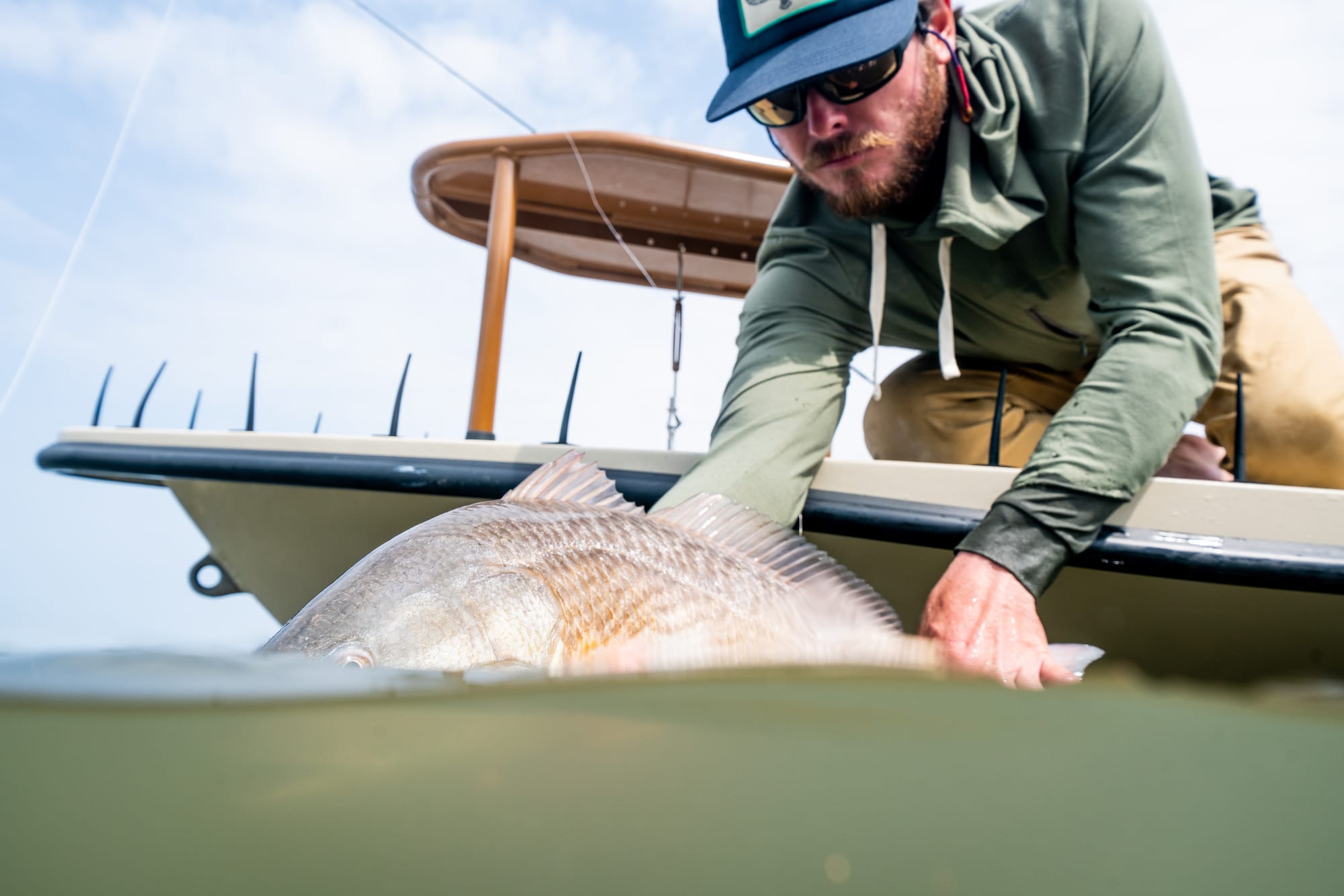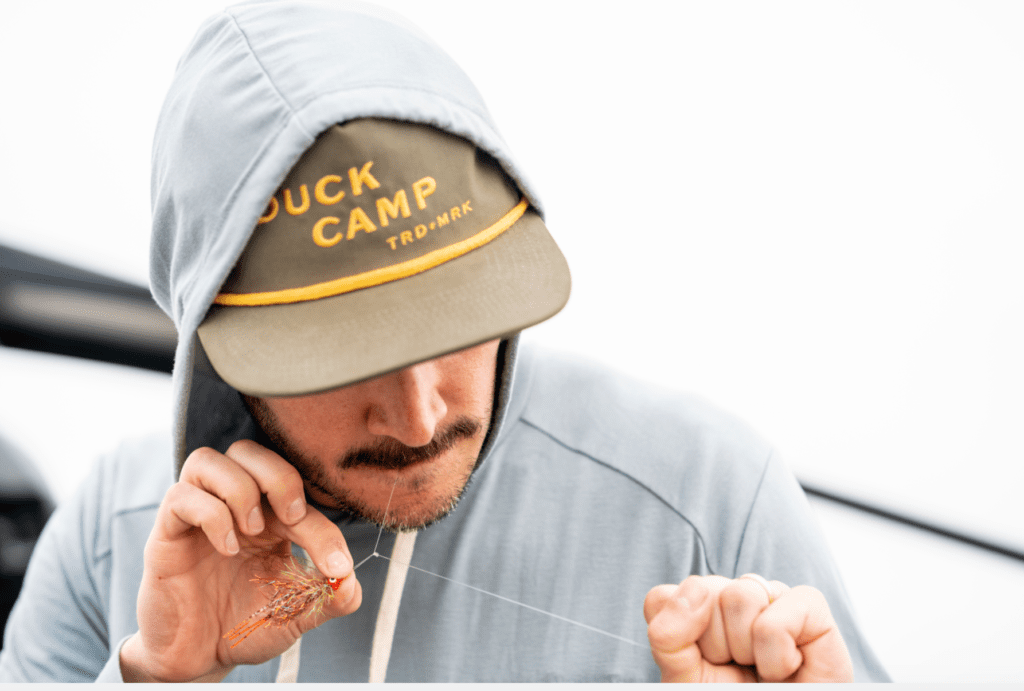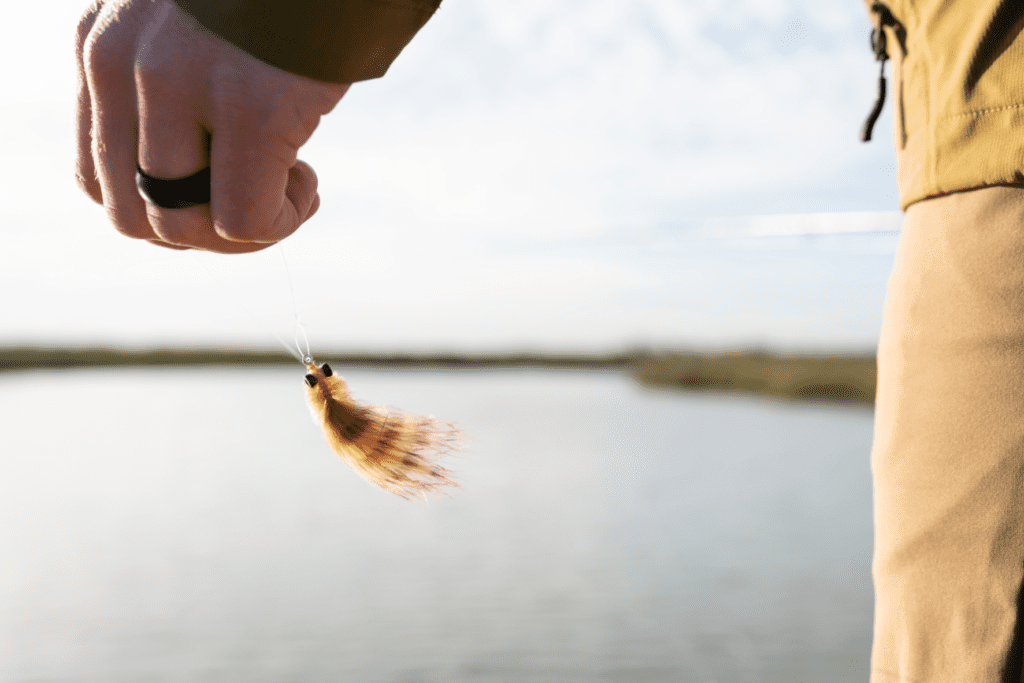Story presented by Duck Camp
We sat down with Port O’Connor fishing guide Capt. OG (Owen Gayler) to discuss his passion, all things fly-fishing. Capt. OG specializes in backcountry sight-fishing adventures.
When did you first start getting into saltwater fly fishing?
In 2010, but I started focusing really hard on saltwater fly-fishing in 2012. It started out on vacation in Florida just fishing from the beach, and then every year I’d fish the Texas coast. I started venturing deeper and deeper into it and just came to love it.
I started out throwing worms, spoons and drifting flats — even soaking a croaker! I also worked on some offshore boats during the summer months. Doing the offshore thing, that’s where I was a mate on a charter boat. I learned to enjoy helping people catch fish. I get just as much joy from that as if I caught the fish.
Was there a ‘hook’ moment when you knew you wanted to become a professional guide?
Yes and no. Being a mate on the boat and going to coastal towns, you can pick the guides out. They have a little swag about them. I wanted to be that dude at the boat ramp pushing the skiff off and walking fast and grabbing ice. Moving with a purpose.
It wasn’t until a few years ago that I started getting serious about it. I fished with Paul Puckett and a few other guys that gave me some more confidence. Once I was fishing more than I was working, it was time to make the call! I enjoy showing people our estuary and sharing the moment of them catching the fish.
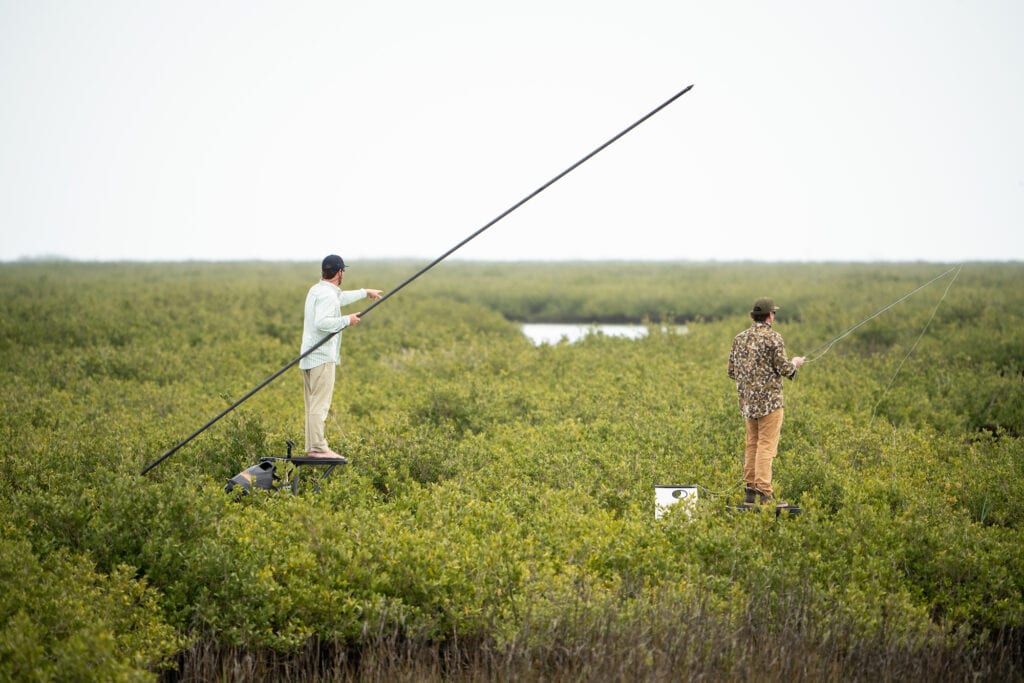
What’s the first thing you teach a novice saltwater fly fisherman on the bow of your boat?
In order to catch a fish, you must see the fish. Especially sight fishing for reds in Texas. Look for a blue crab, stingrays, etc. and while you’re doing that, you’re training your eyeballs to not look at the surface but look through the surface.
Then I go over 3 o’clock, 9 o’clock, 12 o’clock. The angler needs to be square and always have feet pointed at 12 o’clock for this to work.
It all depends on the angler, if they’re experienced, I’ll say, “Redfish 3 o’clock.” I wouldn’t give a distance if the angler is experienced. If I do give a distance, sometimes it makes their eyes too focused on that distance. I ask them how much visibility they have… if they say 30 feet, I won’t tell them to cast at something at 60 feet.
If the angler sees the fish before I see the fish, they have a 50% better chance of catching the fish.
You have to slow people down; they get excited. When they get excited and do a jerk, it moves the bow of the boat and spooks the fish. A lot of guys I take fly-fishing have deer hunted before. I say, when you see a big buck, do you jerk your rifle to your shoulder and pull the trigger? No! You calmly shoulder your rifle, take a deep breath and pull the trigger. Same thing with redfish: let the fish present the shot, take a deep breath, let your fly down. Make the first shot your only shot. If you have to cast a second cast or third cast, your chances go down tremendously because you might be casting at the fish’s tail by that point.
I like for the angler to say, “Alright, I’m on it” calmly. The less time the fly is in the air, the higher the chance is to catch the fish. Fish can see fly line and shadows. It’s not every day that a shrimp or a crab falls out of the sky! Their predators come from over top, so they’re wary.
You also have to have confidence on the bow… You can’t strip 10 feet of line out. You need to get up there and strip some line out and get ready. Stand up straight and lock in on your target and know the fly is going to go there. Hit ‘em in the head, spook ‘em, I don’t care… but don’t go up with a limp, half-assed cast.
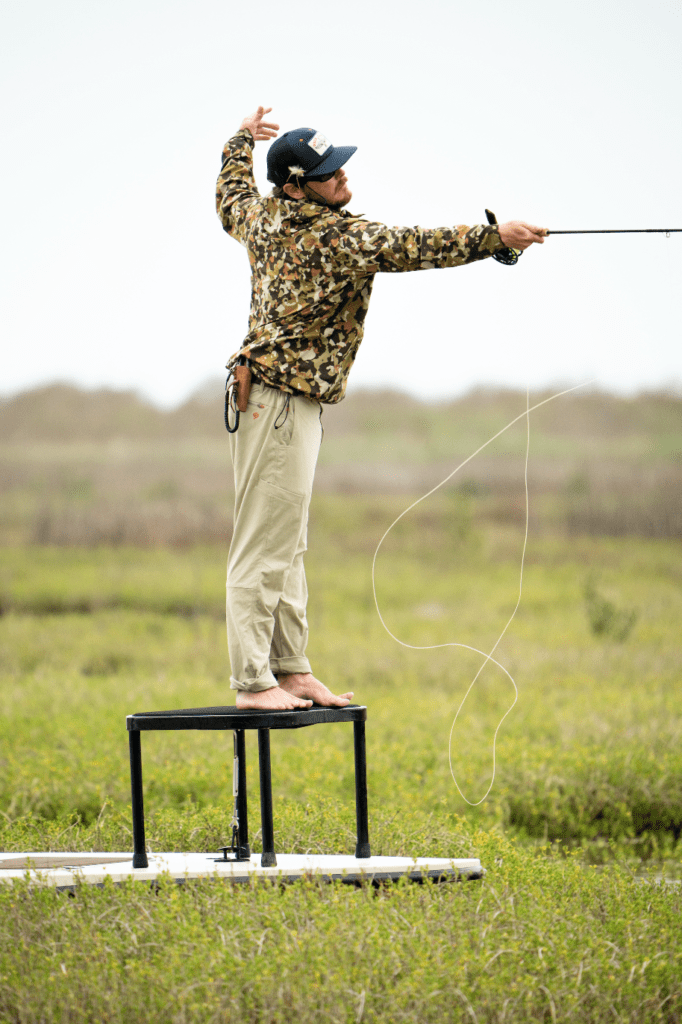
Do you have any tips or techniques for reading the water?
Look at wakes. You need to know the difference between a mullet wake and a redfish wake. If you’re poling next to some spartina grass and you notice ripples coming out from 50 feet away, you may want to poll off the shoreline a little bit and look in there. There’s a high probability there’s a tailing fish in there trying to feed.
Look for clarity in the water. Look for different bottom structures. Use your push pole to feel the different types of bottom. Feel the pole; if it’s soft, you can figure out your pattern based off that first pole.
Look for bait. Look for shrimp popping or glass minnows or shad. Also, look for birds. If you see some white birds standing on a shoreline, there’s fish. They aren’t standing there to look pretty. Or if a group of gulls is gliding over a pond, they’re doing it for a reason. There’s probably something there.
What are your top redfish flies?
Shrimp patterns & crab patterns. A fly that puts off some water. I like a bigger profile and a bigger body so the fish can feel it in their lateral lines. This time of year, in the summer, fish aren’t really feeding on top. But they will in late summer and fall!
Tan colors, blacks and purples. For one, I can see it and the guy casting it can see it. If you can see your fly, you’ll be better at putting the fly in front of the fish’s nose. It’s important to be able to visualize the fly, especially with higher tides.
What are some other species of fish you run across when targeting redfish?
Trout – a lot of times they’ll be laid up. I’ve had some success catching them, but more success not catching them! They’re lethargic; they sit idly digesting whatever they just ate. Trout will eat such large amounts at one time that it’s hard to feed them a little fly. But a new theory I have on that is in order for a trout to digest a 10’’ mullet, it has to have acid in its stomach – so why wouldn’t they eat a little shrimp?
Sheepshead – cast at them if they’re tailing. Or if they are in schools. It depends on how hot the redfish are. You might spook one while trying to catch the sheepshead, so it might not be worth it.
What makes redfish spooky?
In high water, I’m noticing the fish are spooky. There’s more water in the water columns. There’s schools of mullet everywhere and everything is kind of nervous. Also the pressure – there’s more and more people on the water everyday.
Are you seeing more fly fishermen out there lately?
Yes, it’s definitely becoming more popular. Fly-fishermen have done a good job of promoting the sport. We’ve also made it look sexy on social media. To have a picture of a guy releasing a fish with some nice gear and a beautiful background. Lot sexier than an igloo cooler full of dead fish!
The main thing is respect – all of us coastal fishermen have respect for the way they want to do it. Spin gear, fly…it’s all good. It’s about being out in nature and enjoying it.
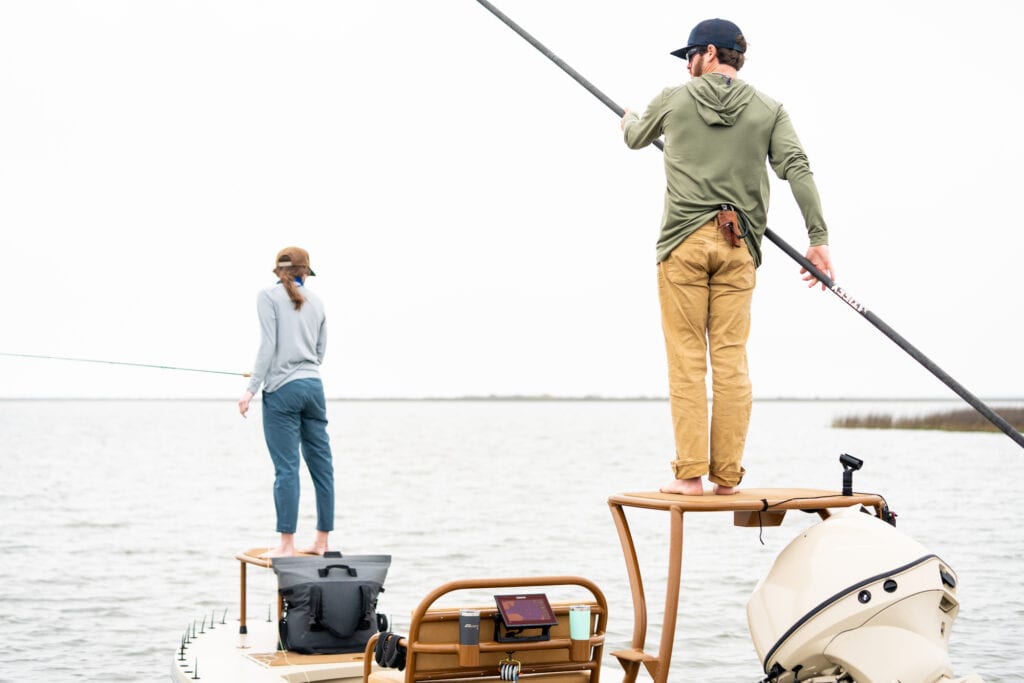
Do you always stay in the boat, or do you get out and wade?
With the high tide, we’ve gotten out and waded some. We’ve had some success the last few weeks. Real skinny, tidal marshes that generally don’t have water in them do right now. It’s fun to wade those because they have a hard bottom. We rarely see stingrays so it’s fun to get out there barefoot and just slide around! Gives you a chance to cool off and it’s fun.
What’s your favorite way to cook redfish?
When I do keep them, my favorite thing to do is to bleed them out. I always keep a stringer on the boat. When the fish is caught, and the angler decides to harvest a few for dinner, I’ll insert the fillet knife in their gill area and go from their gills to their throat and cut up. Let them bleed for 10 minutes and that takes a lot of the color out of the meat. The meat comes out nice and white and fresh. I’m a firm believer in that.
Favorite way to cook them is on the half shell. I like to get the grill pretty hot, put some seasoning on and cook them meat side down for 1 minute, then flip them over to the scale side and let them cook on that side for 3-4 more minutes. Add fresh lemon on top. I love that char.
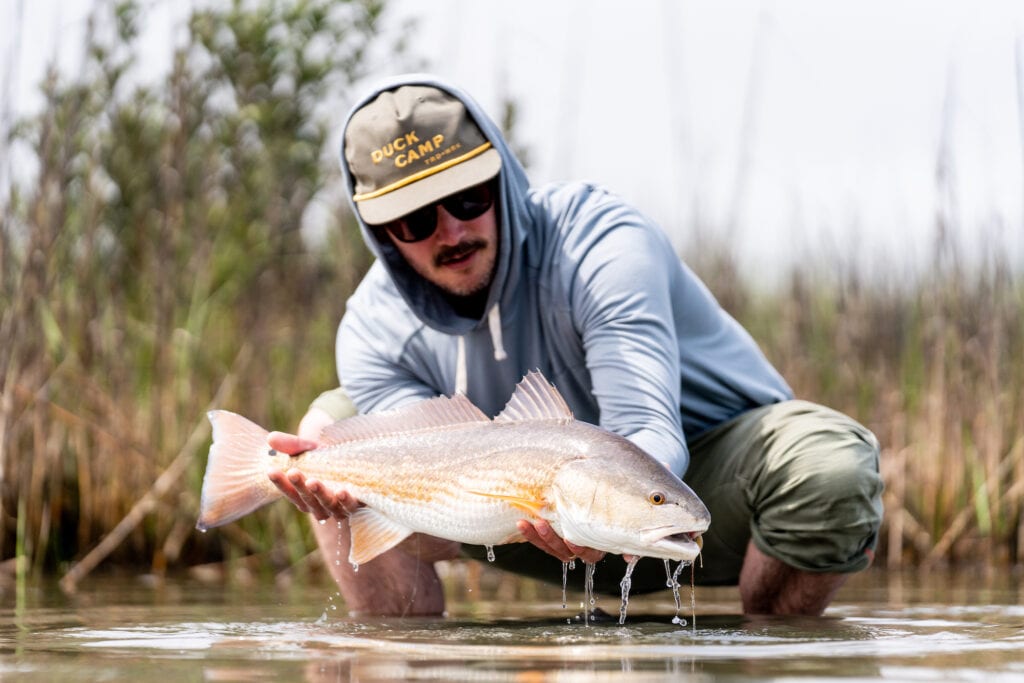
What are some of the best ways to start learning about saltwater fly fishing? Best resources?
If you live in the city, go to your local fly shop. They can hook you up with some knowledge and also a guide to take you out. You’ll learn so much more from a guide.
Before that, do some homework at home or at a park casting your rod. Get comfortable in different situations. Learn to back cast. To get your money’s worth from a guide and be most fulfilled in your trip, you need to know how to cast a backhand cast, a forward cast and be comfortable up to 40 feet in any wind condition. If you can do that, you’re more than capable of catching a fish in our estuary. The guide will build on that and teach you how to double haul and do some other things that will make you a more successful saltwater fly angler.
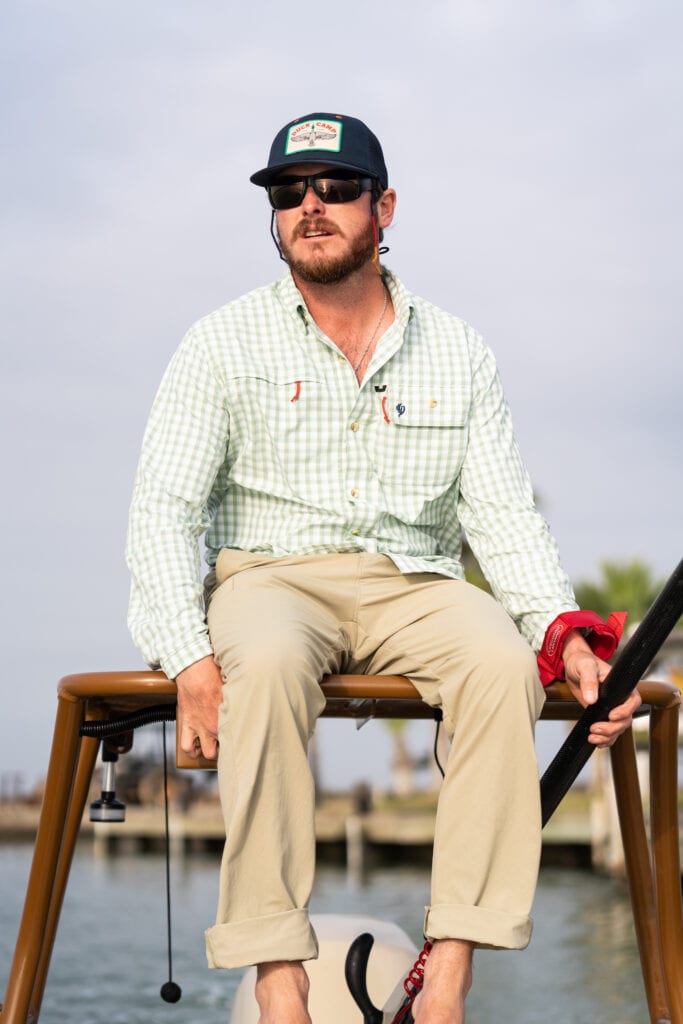
If people want to book you for a trip later this year or in 2021, how do they do that?
I like a good old fashioned phone call the best. My cell is 361-920-2271. Other ways to contact me are via email: txcoastalexperience@gmail.com and my Instagram is @owengayler.
Thank you to Duck Camp for sponsoring this post.


